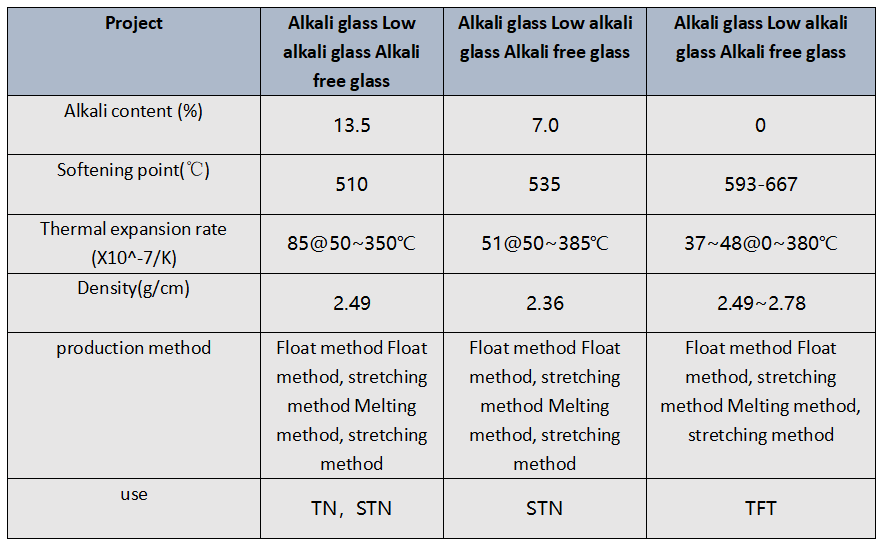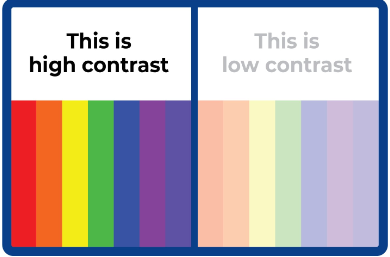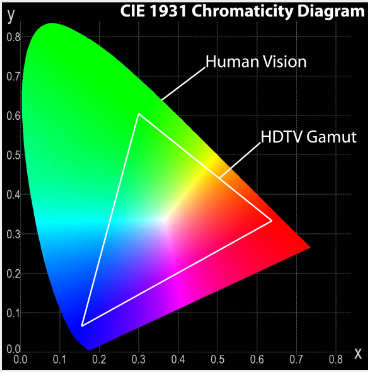Transmittance
The LCD panel itself does not emit light and relies on the light source provided by the backlight to achieve brightness display. Transmittance is an important optical parameter of the LCD panel, and its size directly affects the power consumption of the entire machine. The transmittance calculation method of the panel can be expressed as:
Transmittance = panel surface brightness/backlight brightness

Table 1 : main characteristics of glass for devices
Contrast

The contrast ratio of an LCD monitor refers to the ratio of the brightness at the brightest time to the brightness at the darkest time at a certain point on the screen (usually the center area). The contrast ratio of currently common LCD monitors is generally greater than 1000:1. The higher the contrast, the clearer the image, the more vivid the colors displayed on the display, and the richer the layering.
It can be seen from the definition of contrast that there are two main ways to improve contrast: one is to increase the brightness of the display in the light state, and the other is to reduce the brightness in the dark state, that is, to make the light state brighter and the dark state darker. . Affected by the arrangement state of the liquid crystal, the LCD display will have a certain degree of light leakage in the dark state, that is, the brightness in the dark state cannot reach absolute black, and a slight change in the brightness in the dark state will have a greater impact on the contrast. Therefore, all panel manufacturers in the industry are currently actively exploring ways to reduce dark-state brightness, such as increasing the polarization degree of polarizers, developing high-contrast liquid crystals, improving the orientation characteristics of liquid products, and developing high-contrast color resistance materials.
The contrast often referred to refers to the static contrast, that is, when the backlight maintains normal brightness, the brightness of the panel in the bright and dark states is tested. If in the dark state, the brightness of the backlight can be reduced by circuit control, then a lower panel brightness can be tested in the dark state. This contrast is called dynamic contrast. The dynamic contrast ratio can reach more than 10 000:1.
Response time

There are two types of response times (RT) of LCD displays: black-and-white response time and gray-scale response time. Black and white response time refers to the time it takes for the screen to change from the darkest to the brightest or from the brightest to the darkest, that is, the time it takes for liquid molecules to go from one extreme deflection state to another, including the rise time ( 7 or) and fall time (7 or T). It is usually defined that the time required for the light transmittance to change from 10% to 90% after voltage is applied is; the time required for the light transmittance to change from 90% to 10% after voltage is released is 7. Usually the fall time is longer than the rise time, and the rise time can be further reduced through data signal overdrive technology.
Gray-scale response time, also known as GTG (Gray-to-Gray) response time, refers to the time required for the image brightness to change from one gray level to another. Usually the entire gray scale is divided into several equal parts, and then the response time of these gray scales to each other is tested, and finally the average value is calculated. Therefore, the black-and-white response time is a special case of the gray-scale response time and is also the maximum value.
Response time is an important characteristic parameter of LCD. Excessive response time can easily lead to smearing in dynamic images, and its value is related to the viscosity, elastic constant, thickness of the liquid crystal cell and other factors of the liquid crystal. Currently, methods commonly used to reduce LCD response time include using liquid crystals with low viscosity coefficients, reducing liquid box thickness and over-driving technology.
Perspective
For LCD displays, the picture quality will change when users view the same picture from different angles. The angle range in which the image can be clearly viewed is defined as the viewing angle of the display. Beyond this range, the picture will be blurry. There are three ways to define the viewing angle according to contrast, grayscale inversion and chromatic aberration, which are briefly introduced as follows.
1. Define by contrast
The viewing angle range when the contrast ratio is greater than or equal to 10 is defined as the viewing angle of the LCD. This is the most common method.
2. Define by grayscale inversion
Taking an 8-bit LCD monitor as an example, it is divided into 256 gray levels from black to white. Ideally, the higher the gray level, the brighter the picture will be. However, due to factors such as the arrangement characteristics of the display's liquid crystal, when viewed from a large angle The phenomenon of grayscale inversion occurs, that is, the brightness of low-grayscale images is brighter than the brightness of high-grayscale images. Therefore, the maximum viewing angle without grayscale inversion is defined as the viewing angle of the LCD. This method is generally used in TN mode displays.
3. According to the definition of color shift
Color cast refers to the difference in the color of the same color picture when viewed from the front angle and from an oblique angle. For example, if the picture is white when viewed from the front, the color of the picture seen when squinting beyond a certain angle may be yellowish or bluish. Therefore, the angle at which the color change has become unacceptable is defined as the viewing angle range of the LCD.
Color gamut

The size of the color gamut (CG) reflects the range of colors that the LCD can display. The larger the color gamut, the more colors the LCD can display and the brighter the picture. The expression method of the color gamut, depending on the requirements, is calculated based on the area ratio of the three primary color coordinate points within the chromaticity coordinates, or calculated based on the matching degree of the three primary color coordinate point areas. The realization of wide color gamut is mainly determined by the lamp spectrum of the backlight. The main methods for realizing wide color gamut include BG chip LED+R phosphor, B chip+KSF powder and film materials or lamp tubes using OD powder. Common color gamut standards include NTSC, SRGB, Adobe, etc. See Chapter 4 for details.
Color temperature
Color Temperature (CT) refers to the ideal black body that emits light after being heated, and its luminous color is expressed by the absolute temperature of the heated body. The lower the color temperature, the redder the color is and is called a warm color; the higher the color temperature, the bluer the color is and is called a cool color. People in different regions have different requirements for the color temperature of displays. For example, people who live close to the equator, the average color temperature they see every day is 11000K, so they prefer cold color temperatures. On the contrary, people in areas with higher latitudes prefer warm colors (color temperature). 6500K). LCDs have different color temperature requirements depending on the type. For example, the color temperature standard for common TV products is 10,000K, and the color temperature standard for MNT and NB products is 6500K.